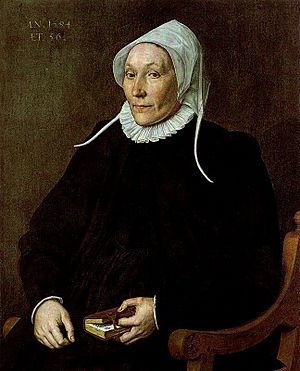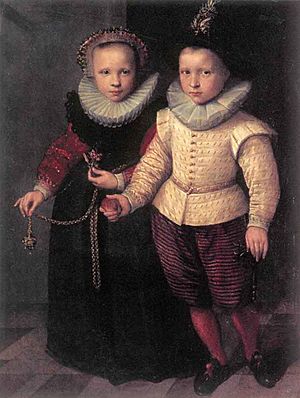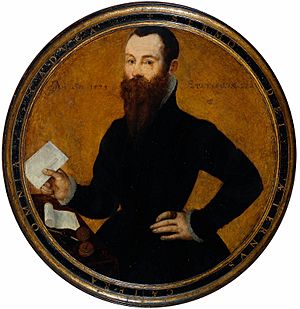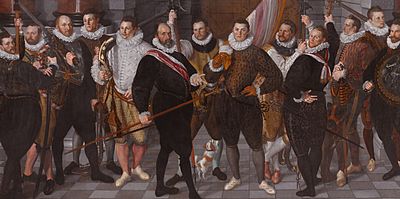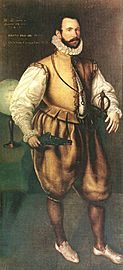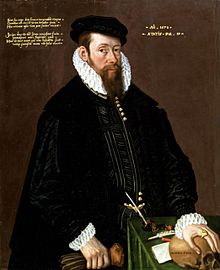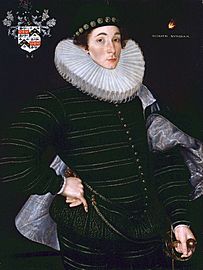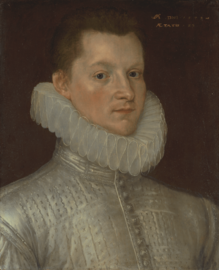Cornelis Ketel facts for kids
Quick facts for kids
Cornelis Ketel
|
|
|---|---|
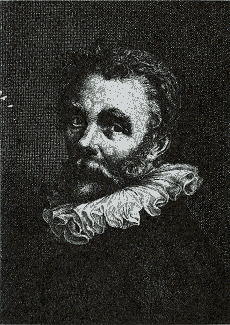
Cornelis Ketel by Hendrik Bary
|
|
| Born | March 18, 1548 |
| Died | August 8, 1616 (aged 68) |
| Known for | Painting |
| Movement | Mannerism |
Cornelis Ketel (born March 18, 1548 – died August 8, 1616) was a talented Dutch painter. He was known for his unique style called Mannerism. Cornelis Ketel worked in London, England, from 1573 to 1581. After that, he moved to Amsterdam, where he lived until he passed away.
Ketel was mostly famous for painting portraits of people. But he was also a poet and a speaker. Later in his life, starting in 1595, he even became a sculptor.
According to his friend and biographer, Karel van Mander, Cornelis Ketel really wanted to paint big historical scenes. These included stories from myths. However, after he left France, he became known almost entirely for his portraits. At that time, neither England nor Holland had much demand for large history paintings. Sadly, none of his big historical or story-telling paintings have survived. We only have drawings and prints of them. Still, he greatly influenced how large group portraits were painted in the Dutch Republic.
Contents
Life of Cornelis Ketel
Cornelis Ketel was born in Gouda in 1548. His mother was Elisabeth Jacobsdr. Ketel. His father was Govert Jans van Proyen, who collected art. A famous glass painter from Gouda, Dirck Crabeth, encouraged him to start painting. He became a student of his uncle, Cornelis Jacobsz.
When he was 18, he studied with the Delft painter Anthonie Blocklandt. Later, he traveled to Paris. There, he lived with Jean de la Hame, who was a glass-painter for King Charles IX. From Paris, he went to Fontainebleau in 1566. This trip helped him develop his love for the Mannerist style of art. He had to leave France in 1567. This was because all citizens from the Habsburg Netherlands were told to leave.
He returned to Gouda, but life there was hard. The city was taken over by rebels in 1572. Then, a plague in 1573 killed many people. The Dutch Revolt also made daily life very unstable.
Moving to London
Next, Ketel moved to England. He was one of several Dutch artists working for the Tudor court in the 1570s. Cornelis Ketel married Aeltgen Gerrits in London in 1573. His biographer, Karel van Mander, mentions his portraits of important people. These included Sir Christopher Hatton and the Earl of Oxford. He also painted many other noblemen, their wives, and children. In 1578, he was allowed to paint Queen Elizabeth I. This happened when she visited Anne Seymour, Duchess of Somerset at Hanworth Park House.
Ketel found that people in England were not interested in his allegorical paintings. These were paintings that told a story using symbols. So, he returned to the Netherlands. His son, Rafaël, was born in Amsterdam in 1581. Ketel became very successful in the Netherlands. He introduced the idea of full-length group portraits to Dutch citizens. Most of his work became portrait painting.
The Dutch people, after their revolt, did not like Mannerist art or mythological subjects. They linked these styles to the Habsburg rulers they were fighting against. Ketel also painted some religious scenes. He was likely a Remonstrant, like his friend Hendrick de Keyser. Hendrick was a city architect and sculptor. Cornelis Ketel's son, Thomas de Keyser, was also a successful portrait painter. Cornelis van der Voort and Pieter Isaacsz were also students of Ketel.
After his first wife died in 1602, he married Aeltge Jans in 1607. This marriage produced one son, Andries, who died very young. Ketel became ill and made his will in November 1613. He passed away in August 1616.
Cornelis Ketel's Artworks
Paintings from London
Ketel quickly became a successful portrait painter in London. Karel van Mander wrote that rich German merchants supported him. These merchants were part of the Hansa. A painting he made, called Force overcome by Wisdom and Prudence, was given to Sir Christopher Hatton. This helped Ketel become known in the royal court. Hatton then asked Ketel to paint his portrait. Queen Elizabeth I also sat for him in 1578.
Ketel painted many works during these years, but many are now lost. In 1577, he was asked to paint 19 portraits for the Cathay Company. One famous painting from this time is of Martin Frobisher. It shows him full-length and is now in the Bodleian Library. Ketel also painted several "great" pictures of Kalicho. Kalicho was an Inuit man Frobisher brought to England. Ketel's self-portrait was later made into an engraving by Hendrick Bary. It is now in the Royal Collection.
Recently, a group of head-and-shoulders paintings were identified as Ketel's work. These paintings, from 1579, show members of the family of Thomas "Customer" Smythe. They are now spread out in different collections.
Most of Ketel's allegorical paintings are lost. However, a lost masterpiece was found and shown in London in 1995. It was part of an exhibition called Dynasties. Painting in Tudor and Jacobean England 1530-1630. This painting might be the lost "Triumph of Wisdom and Prudence over Force" from 1580. This rediscovered piece is one of the few remaining examples of his allegorical works.
Records show that Ketel charged £1 for a head-and-shoulders portrait. He charged £5 for a full-length portrait. For comparison, Nicholas Hilliard, a famous miniature painter, usually charged £3 for a small portrait.
Later Works in Amsterdam
Some of Ketel's history paintings are known through other records. For example, Rembrandt, when he was about thirteen, copied Ketel's paintings of Democritus and Heraclitus. These were perhaps tronies. Tronies are imaginary portraits of people from myths or history. A story by van Mander tells of a farmer trying to explain Ketel's Danae to his wife. He got it mixed up with an Annunciation.
Ketel's 1588 painting, The Company of Captain Rosecrans, was very important. It was the first Dutch group portrait to show figures standing full-length. This painting greatly influenced later artists who painted militia groups. Famous painters like Rembrandt (in his Night Watch) and Frans Hals were inspired by it. Ketel, like Hals, placed his subjects side-by-side in a row. But Rembrandt later spread his subjects deeper into the painting. The Company of Captain Rosecrans painting has been cut down on all sides. Originally, the city gate behind the group was much more visible.
For many years, Ketel was a leading portrait painter in Amsterdam. He worked alongside Pieter Pietersz. They were part of a generation of Dutch portrait painters. Their skilled work helped set the stage for even more famous artists later on. In England, oil portraits were mostly for the court and rich families. But in the Netherlands, they were common among successful merchants. Ketel lived near the Oude Kerk. In 1593, he bought a house on the "Velvet Canal."
Both Ketel and Pietersz developed a special Amsterdam style. They often showed people very close to the front of the painting. They used unusual angles and cropped the figures closely. Ketel seemed to have a collection of drawings of poses. A customer could choose a pose, and his assistants could work on the painting. This meant the person didn't always need to be there. Van Mander wrote that around 1600, Ketel sometimes painted without a brush. He used his fingers, and even his feet and toes! He might have done this to entertain himself and his customers. Another idea is that he had a condition like arthritis. This might have made it hard for him to use his hands.
Gallery
See also
 In Spanish: Cornelis Ketel para niños
In Spanish: Cornelis Ketel para niños


